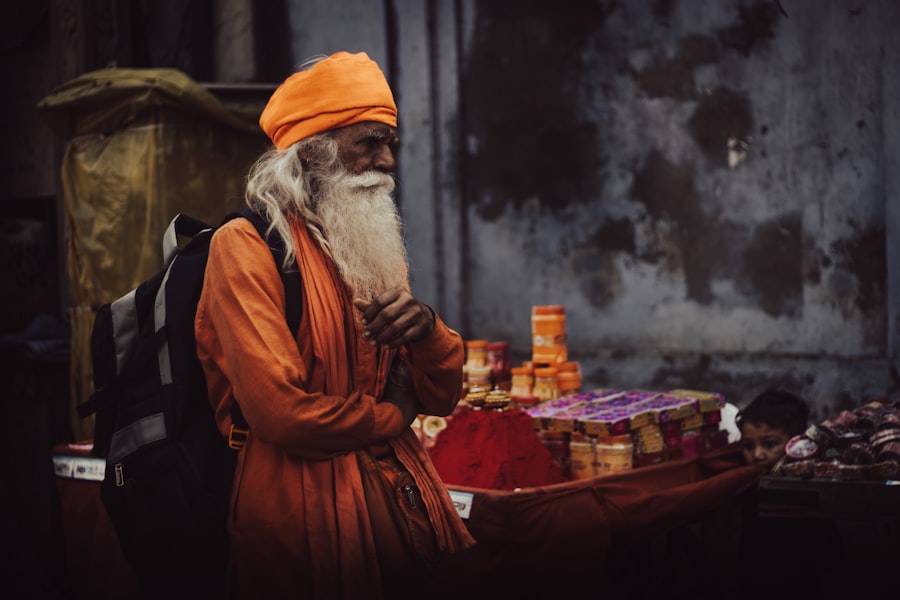Vaishnavism, one of the principal traditions within Hinduism, traces its origins back to the Vedic texts, where the concept of Narayana emerges as a significant deity. Narayana is often identified with Vishnu, the preserver and protector within the Hindu trinity, which also includes Brahma the creator and Shiva the destroyer. The earliest references to Narayana can be found in the Rigveda, where he is depicted as a cosmic being who pervades the universe.
As the tradition evolved, Narayana’s identity became more complex and multifaceted. The Upanishads and Puranas further elaborated on his nature, presenting him as the ultimate reality (Brahman) and the source of all creation.
The Bhagavad Gita, a key text in Hindu philosophy, also plays a crucial role in shaping Vaishnavism by presenting Krishna, an avatar of Vishnu, as a divine guide and teacher. This transition from Narayana to Krishna marks a significant shift in the focus of worship and devotion within Vaishnavism, laying the groundwork for a rich tapestry of beliefs and practices that would flourish in subsequent centuries.
Key Takeaways
- Vaishnavism traces its origins from the worship of Narayana, the supreme deity, and later evolved to focus on Krishna as the central figure.
- Narayana is considered the ultimate reality and is worshipped as the source of all creation and the sustainer of the universe in Vaishnavism.
- The evolution of Krishna as the central figure in Vaishnavism is marked by his portrayal as a divine lover, a mischievous child, and a compassionate teacher in Hindu scriptures.
- Vaishnavism emphasizes the philosophical teachings of dharma (duty), karma (action), and moksha (liberation) as the path to spiritual enlightenment and self-realization.
- Bhakti, or devotion, is considered the most important aspect of Vaishnavism, as it is believed to lead to a deep and personal connection with the divine.
The Concept of Narayana in Vaishnavism
In Vaishnavism, Narayana is revered not only as a deity but also as a philosophical concept representing the ultimate reality. He embodies the principles of dharma (righteousness) and is often associated with the preservation of cosmic order. The notion of Narayana transcends mere anthropomorphism; he is seen as an all-encompassing force that sustains the universe.
This understanding is deeply rooted in the texts of the Puranas, particularly the Vishnu Purana, which elaborates on his divine attributes and cosmic functions. Narayana’s role as a protector and sustainer is further emphasized through various myths and legends that illustrate his interventions in times of crisis. For instance, his descent into the material world to restore balance during periods of chaos is a recurring theme in Vaishnavite literature.
This narrative not only highlights his omnipotence but also reinforces the belief that he is accessible to his devotees. The concept of Narayana thus serves as a bridge between the abstract philosophical ideas of Brahman and the more personal, relatable figure of Krishna, who embodies these divine qualities in a more tangible form.
The Evolution of Krishna as the Central Figure in Vaishnavism

Krishna’s evolution from a minor deity in early texts to the central figure of Vaishnavism is a fascinating journey marked by cultural and theological developments. Initially mentioned in the Rigveda as a god associated with agriculture and pastoral life, Krishna’s character began to take on more significance in later texts such as the Mahabharata and the Bhagavata Purana. In these narratives, he is portrayed not only as a divine hero but also as a playful child and a wise philosopher, embodying various aspects of human experience.
The Bhagavad Gita, part of the Mahabharata, is particularly instrumental in establishing Krishna’s prominence within Vaishnavism. In this text, Krishna serves as Arjuna’s charioteer and imparts profound spiritual wisdom that addresses fundamental questions about duty, righteousness, and devotion. His teachings emphasize the importance of surrendering to God and recognizing one’s place within the cosmic order.
This philosophical depth, combined with his charismatic personality, solidified Krishna’s status as an object of devotion for millions of followers. As Krishna’s narrative expanded through folk traditions and regional practices, he became associated with various forms of worship, including rituals, festivals, and artistic expressions. The celebration of Janmashtami, marking his birth, and Holi, symbolizing his playful nature, are just two examples of how Krishna’s character has permeated Indian culture.
His stories have inspired countless works of art, music, and dance, further embedding him into the fabric of Indian spirituality.
The Philosophical Teachings of Vaishnavism
The philosophical underpinnings of Vaishnavism are rich and diverse, drawing from various texts that articulate its core tenets. Central to Vaishnavite philosophy is the concept of bhakti or devotion, which emphasizes a personal relationship with God. This relationship is characterized by love, surrender, and an unwavering faith in Narayana or Krishna as the ultimate source of grace.
The teachings found in texts like the Bhagavad Gita and the writings of later philosophers such as Ramanuja and Madhva provide a framework for understanding this devotion. In addition to bhakti, Vaishnavism also addresses concepts such as karma (the law of cause and effect) and moksha (liberation from the cycle of birth and death). The belief that one’s actions have consequences reinforces ethical living and adherence to dharma.
Furthermore, Vaishnavite philosophy posits that through sincere devotion and worship, individuals can attain moksha and unite with the divine. This idea resonates deeply with followers who seek both spiritual fulfillment and moral guidance in their lives. The philosophical discourse within Vaishnavism has also led to various schools of thought that interpret these teachings differently.
For instance, Ramanuja’s Vishishtadvaita (qualified non-dualism) emphasizes the importance of personal devotion while acknowledging the distinction between the individual soul (jiva) and God (Brahman). In contrast, Madhva’s Dvaita (dualism) asserts a clear separation between God and individual souls. These differing perspectives enrich Vaishnavite philosophy and provide followers with diverse pathways to explore their spirituality.
The Importance of Bhakti (Devotion) in Vaishnavism
Bhakti serves as the cornerstone of Vaishnavism, shaping its practices, rituals, and community life. This form of devotion transcends mere ritualistic worship; it embodies an emotional connection between the devotee and God. Bhakti is characterized by love, surrender, and an intimate relationship with Krishna or Narayana.
The emotional intensity associated with bhakti is often expressed through poetry, music, dance, and storytelling, creating a vibrant cultural landscape that celebrates divine love. The significance of bhakti can be traced back to early saints like Namdev and Mirabai, who emphasized personal devotion over ritualistic practices. Their compositions often reflect deep emotional experiences and longing for union with the divine.
This emphasis on personal connection has made bhakti accessible to people from all walks of life, allowing them to engage with spirituality on their own terms. The inclusive nature of bhakti has fostered a sense of community among devotees who gather for collective worship and celebrations. Moreover, bhakti has played a crucial role in social reform movements within India.
Many bhakti saints challenged caste hierarchies and social norms by advocating for equality among all devotees regardless of their background. This democratization of spirituality has had lasting effects on Indian society, promoting values of compassion, humility, and service. Through bhakti practices such as kirtan (devotional singing) and satsang (spiritual gatherings), devotees cultivate a sense of belonging while deepening their connection to God.
The Spread of Vaishnavism and its Influence on Indian Culture and Society

The spread of Vaishnavism across India has been marked by its adaptability to regional cultures and traditions. From its early roots in North India to its flourishing presence in South India through figures like Ramanuja and Chaitanya Mahaprabhu, Vaishnavism has embraced local customs while maintaining its core teachings. This adaptability has allowed it to resonate with diverse populations, leading to its establishment as one of the most widely practiced forms of Hinduism.
Vaishnavism’s influence extends beyond religious practices; it has significantly shaped Indian art, literature, music, and dance. The intricate sculptures found in temples dedicated to Vishnu or Krishna reflect not only religious devotion but also artistic excellence that has inspired generations of artisans. Classical dance forms like Bharatanatyam often depict stories from Krishna’s life or highlight themes from Vaishnavite philosophy through expressive movements.
In contemporary society, Vaishnavism continues to play a vital role in shaping cultural identity and community life. Festivals such as Diwali and Janmashtami are celebrated with great enthusiasm across India and among Indian diasporas worldwide. These celebrations foster communal harmony while reinforcing shared values rooted in devotion to God.
The enduring legacy of Vaishnavism lies not only in its theological teachings but also in its ability to inspire individuals toward spiritual growth while fostering social cohesion. Its emphasis on love for God transcends boundaries, inviting people from diverse backgrounds to partake in its rich traditions.
As it continues to evolve in response to contemporary challenges, Vaishnavism remains a vital force within Indian culture and spirituality.
If you are interested in exploring the relationship between Vaishnavism and other spiritual philosophies, you may find Sri Aurobindo and Gandhian Philosophy: Exploring Spiritual Evolution and Non-Violent Resistance to be a fascinating read. This article delves into the spiritual teachings of Sri Aurobindo and Mahatma Gandhi, shedding light on their philosophies of non-violence and spiritual evolution. It offers valuable insights into how these teachings intersect with the principles of Vaishnavism, providing a deeper understanding of the interconnectedness of different spiritual traditions.
FAQs
What is Vaishnavism?
Vaishnavism is a major tradition within Hinduism that worships Vishnu, one of the principal deities of the religion. Followers of Vaishnavism, known as Vaishnavas, believe in the ultimate goal of achieving moksha (liberation) through devotion to Vishnu and his avatars.
Who is Narayana in Vaishnavism?
In Vaishnavism, Narayana is considered the original form of Vishnu, the supreme deity. Narayana is often depicted as the source of all creation and the ultimate reality in the universe.
How does Krishna relate to Vaishnavism?
Krishna is one of the most popular and widely worshipped avatars of Vishnu in Vaishnavism. He is revered as the eighth incarnation of Vishnu and is the central figure in the sacred text, the Bhagavad Gita.
What are the main beliefs of Vaishnavism?
Vaishnavism emphasizes the importance of bhakti (devotion) as the primary means of attaining spiritual liberation. Followers believe in the concept of samsara (cycle of birth and death) and seek to break free from this cycle through devotion to Vishnu and his avatars.
How is Vaishnavism practiced?
Vaishnavism is practiced through various rituals, prayers, and devotional activities such as singing hymns, performing puja (worship), and participating in religious festivals. Many Vaishnavas also engage in acts of seva (selfless service) as a way of expressing their devotion to Vishnu.






















+ There are no comments
Add yours